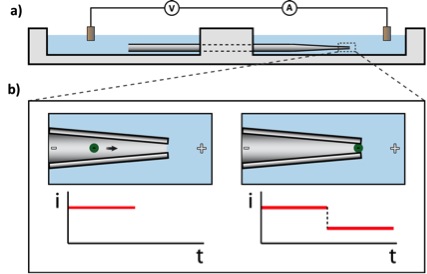
Nucleic Acid Detection

(a) Cross-sectional diagram of the pipet and measurement chamber.
(b)Depiction of pipet tip and measured current
Detection of nucleic acids (NAs) of specific sequence is of value for infectious disease diagnostics, detection of pathogenic food contaminants, and biowarfare agent sensing, among many other applications. In NIH-funded work, we recently demonstrated in collaboration with the Schmidt lab (UCLA Bioengin. Dept.) the concept for a PCR-free, and fluorescent and enzymatic label-free approach for detection of target NA sequences at low concentrations and with selectivity against single-base mismatch NA using simple, low-cost electronics. The device is based on measurement of a strong step change in conductance of a single electrolyte-filled pore in response to target NA presence. Negatively charged target NA, when present, binds to charge-neutral beads conjugated to complementary peptide nucleic acid capture probes that then become electrophoretically mobile and block the pore, strongly attenuating the measured conductance. We recently have achieved NA detection at 10 femtomolar and currently are engaged in scaling down our device using silicon micromachining technology in order to achieve sub-femtomolar detection. An international patent application has been filed, and this research is continuing with NSF funding.
Students
Publications
Esfandiari, Leyla, Monbouquette, Harold G., Schmidt, Jacob J., Sequence-specific nucleic acid detection from binary pore conductance measurement, J. Am. Chem. Soc., 134, 15880-15886 (2012)
Esfandiari, Leyla, Lorenzini, Michael, Kocharyan, Gayane, Monbouquette, Harold G., Schmidt, Jacob J., Sequence-Specific DNA Detection at 10fM by Electromechanical Signal Transduction, Anal. Chem., 86, 9638-9643 (2014)
Copyright © Monbouquette Laboratory.
Last updated: 03/10/2015